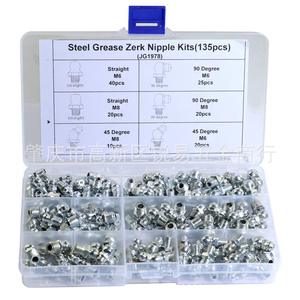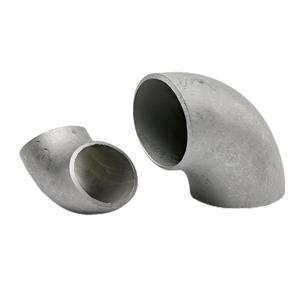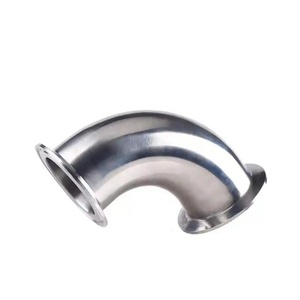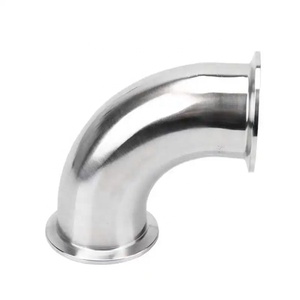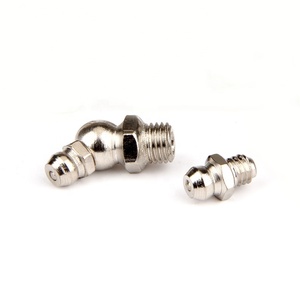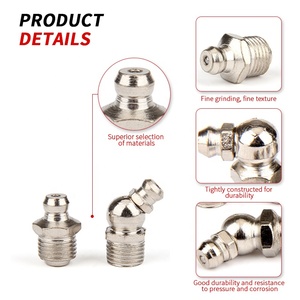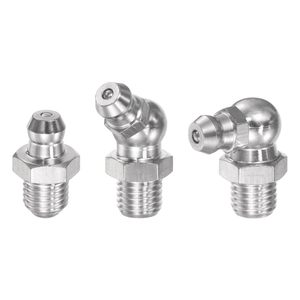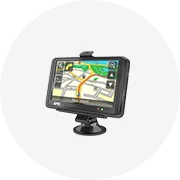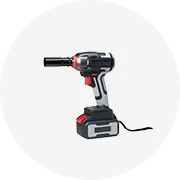Types of 90-Degree Grease Fittings
90-degree grease fittings provide an angled solution for lubricating hard-to-reach components in machinery and equipment. These specialized fittings come in various designs to accommodate different applications and operating conditions.
Standard 90-Degree Grease Fitting
The most common design with a simple 90-degree angle, also known as an elbow grease fitting. Available in various sizes and thread types to accommodate different applications.
Best for: Tight spaces where straight fittings cannot reach
Swivel 90-Degree Grease Fitting
Features a rotating joint that allows the fitting to move freely in different directions, reducing stress on the fitting and grease line.
Best for: Moving parts and applications where the angle of approach changes
Heavy-Duty 90-Degree Grease Fitting
Constructed from robust materials to withstand high-pressure grease injections and harsh operating environments.
Best for: Industrial equipment and heavy machinery with large moving parts
Captive Ball 90-Degree Grease Fitting
Contains an internal ball mechanism that seals the fitting when not in use, preventing contaminants from entering the grease reservoir.
Best for: High-contamination environments like construction or agricultural equipment
Threaded 90-Degree Grease Fitting
Features threads on the body for installation in threaded ports or adapters, offering secure connections for permanent installations.
Best for: Applications requiring standard threaded connections
Non-Threaded 90-Degree Grease Fitting
Has plain ends without threads, typically installed using welding or mechanical fastening methods.
Best for: Custom installations requiring welding or press-fit applications
Expert Tip: When installing 90-degree grease fittings in confined spaces, consider using a swivel type to reduce the risk of damaging the fitting during maintenance operations.
| Fitting Type | Key Features | Best Applications | Maintenance Level |
|---|---|---|---|
| Standard 90° | Simple elbow design | General machinery, tight spaces | Low |
| Swivel 90° | Rotating joint | Moving components, variable access angles | Medium |
| Heavy-Duty 90° | Reinforced construction | Industrial equipment, high-pressure applications | Low |
| Captive Ball 90° | Self-sealing mechanism | Contaminated environments | Medium |
| Threaded 90° | Standard thread patterns | Permanent installations | Low |
Specifications and Maintenance
Understanding the technical specifications and proper maintenance procedures for 90-degree grease fittings is essential for optimal performance and longevity.
Technical Specifications
Maintenance Best Practices
| Maintenance Task | Frequency | Procedure | Benefit |
|---|---|---|---|
| Cleaning | After each use/Monthly | Wipe with clean cloth, remove dirt and debris | Prevents contamination of bearings and moving parts |
| Inspection | Quarterly | Check for cracks, deformation, or thread damage | Early detection of potential failures |
| Lubrication | Per equipment manual | Apply appropriate grease type and quantity | Reduces friction and wear on components |
| Excess Grease Removal | After lubrication | Clean excess grease from fitting and surrounding area | Prevents dirt accumulation and contamination |
| Replacement | When damaged | Remove old fitting, install new one with proper torque | Maintains system integrity and prevents failures |
Important: Never over-tighten grease fittings during installation or maintenance. This can damage the threads or distort the fitting, leading to leaks or failure. Always follow manufacturer torque specifications.
How to Choose 90-Degree Grease Fittings
Selecting the right 90-degree grease fitting for your application is crucial for ensuring proper lubrication and extending equipment life. Consider these key factors when making your selection:
Application Type
Different industries and equipment have specific requirements for grease fittings:
- Automotive: Requires fittings that can access tight spaces around joints, bushings, and bearings
- Heavy Machinery: Needs durable fittings that can withstand vibration and high-pressure greasing
- Agricultural: Benefits from sealed fittings that resist contamination from dirt and debris
Material Selection
Choose based on operating environment and conditions:
- Brass: Excellent corrosion resistance, ideal for marine or humid environments
- Steel: High strength for general applications at moderate cost
- Stainless Steel: Premium durability and corrosion resistance for harsh environments
Thread Size and Type
Must match the pre-tapped holes in your equipment:
- UNC (Unified National Coarse): Common in American-made equipment
- NPT (National Pipe Thread): Standard for pipe connections in North America
- Metric: Common in European and Asian equipment
- BSP (British Standard Pipe): Used in British and Commonwealth countries
Fitting Design Features
Special features to consider for specific needs:
- Swivel Capability: For equipment with moving parts requiring flexible access
- Pressure Rating: Must exceed the maximum pressure of your grease gun
- Sealing Mechanism: Such as captive ball designs for contaminated environments
- Space Constraints: Consider compact designs for tight access areas
Selection Tip: When in doubt about thread size or type, bring the old fitting to your supplier for matching, or use a thread gauge to accurately identify the existing thread pattern.
How to DIY and Replace 90-Degree Grease Fitting
Replacing a 90-degree grease fitting is a straightforward maintenance task that can be completed with basic tools. Follow this step-by-step guide for a successful replacement:
Locate the part of the machine or vehicle where the grease fitting needs replacement. This could be a joint, bearing, or pivot point that requires regular lubrication.
- Wrench or socket set (appropriate size for your fitting)
- Grease gun with compatible nozzle
- Wire brush for cleaning
- Thread sealant (if recommended by manufacturer)
- Clean rags
- Penetrating oil (for stuck fittings)
Use the appropriate wrench or socket to carefully unscrew the old grease fitting. If it's stuck, apply penetrating oil and allow it to sit for 10-15 minutes before attempting removal. Take care not to damage the threads in the component.
Inspect the new 90-degree grease fitting for any manufacturing defects. Clean the threads with a wire brush if necessary. Apply a small amount of thread sealant to the threads if required (check equipment manufacturer recommendations).
Carefully thread the new grease fitting into the component by hand initially to prevent cross-threading. Once properly aligned, use the wrench or socket to tighten until snug. Avoid over-tightening which can damage both the fitting and component.
Connect your grease gun to the newly installed fitting and apply the appropriate amount of grease. Continue until you see a small amount of clean grease emerging from the bearing or joint, indicating that old grease and contaminants have been purged.
Inspect the area around the fitting for any signs of grease leakage. If leaks are present, verify the fitting is properly tightened or consider replacing it with a different size or type.
Wipe away any excess grease from the fitting and surrounding area. Proper cleanup prevents dirt accumulation which can lead to premature wear.
Operate the equipment or vehicle to ensure the component with the new grease fitting functions correctly. Listen for unusual noises that might indicate improper installation or lubrication.
Safety Warning: Always consult your equipment's service manual before performing maintenance. Some components may require specific grease types or quantities. Never work on machinery that hasn't been properly shut down and secured.
Questions and Answers
90-degree grease fittings are specialized lubrication components designed to deliver grease to bearings, joints, and moving parts in hard-to-reach areas. Their angled design allows access to confined spaces where straight fittings cannot reach, making them invaluable for:
- Ensuring proper lubrication of critical mechanical components
- Extending the service life of bearings and moving parts
- Reducing friction and wear in machinery and equipment
- Facilitating maintenance in tight or awkward spaces
90-degree grease fittings are widely used across multiple industries wherever equipment requires regular lubrication in confined spaces:
| Industry | Common Applications |
|---|---|
| Automotive | Ball joints, tie rod ends, universal joints, steering components |
| Construction | Excavators, loaders, bulldozers, articulating joints |
| Agriculture | Tractors, harvesters, implements, pivot points |
| Manufacturing | Conveyor systems, robotic arms, production machinery |
| Marine | Steering systems, winches, davits, deck equipment |
90-degree grease fittings offer several distinct advantages over straight or other angled fittings in specific applications:
- Space Efficiency: Their right-angle design provides access to lubrication points in tight spaces where straight fittings cannot reach
- Reduced Stress: The angled design reduces strain on grease hoses and connectors during maintenance operations
- Protection from Damage: Positioning away from moving parts or potential impact areas increases longevity
- Improved Ergonomics: Allows technicians to apply grease from more comfortable positions, especially in confined maintenance areas
- Even Distribution: Provides reliable grease delivery to crucial components, ensuring proper lubrication and extended equipment life
The right-angle configuration makes these fittings the preferred choice when access is limited or when the grease gun must approach from a direction perpendicular to the lubrication point.




